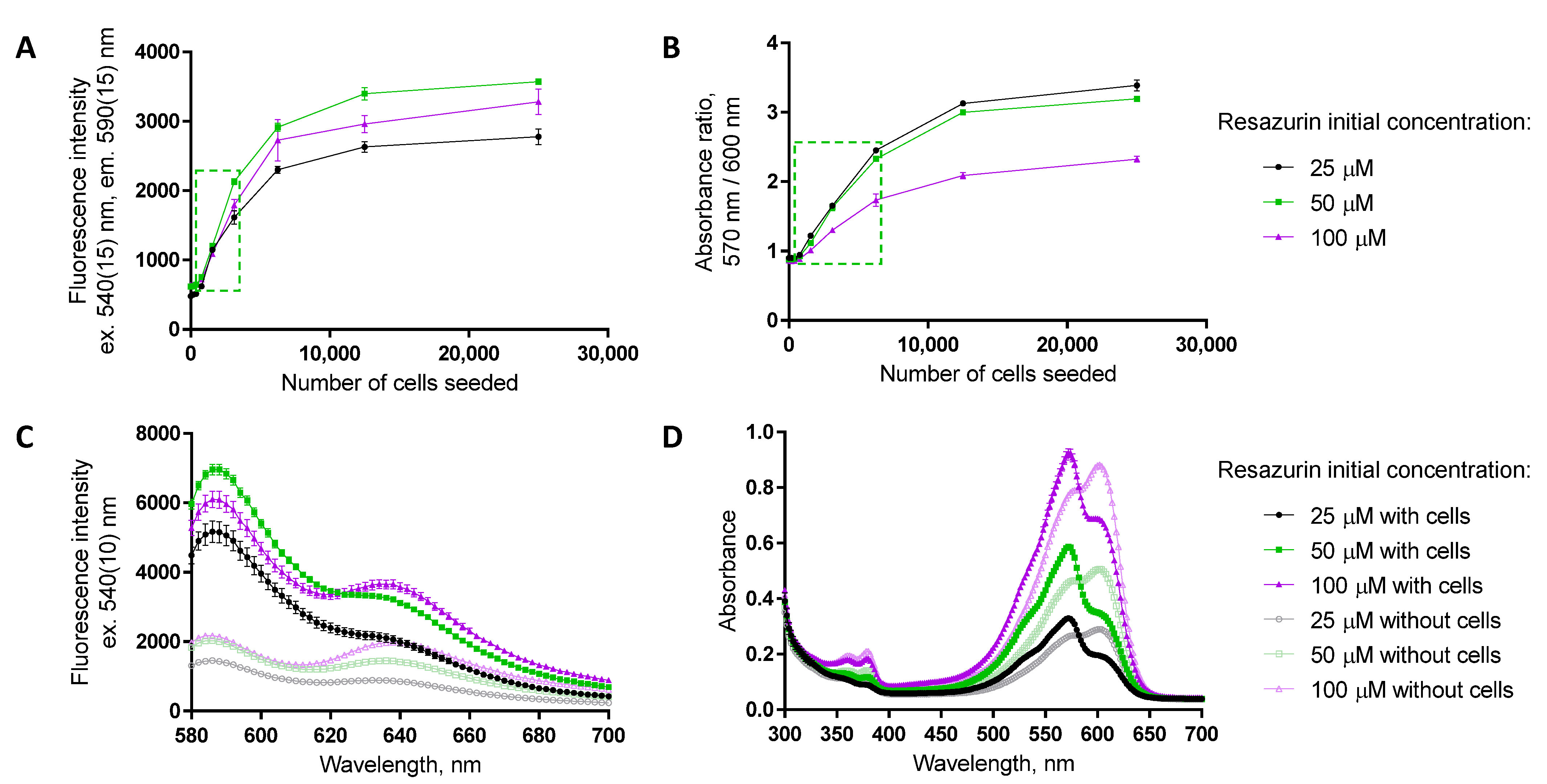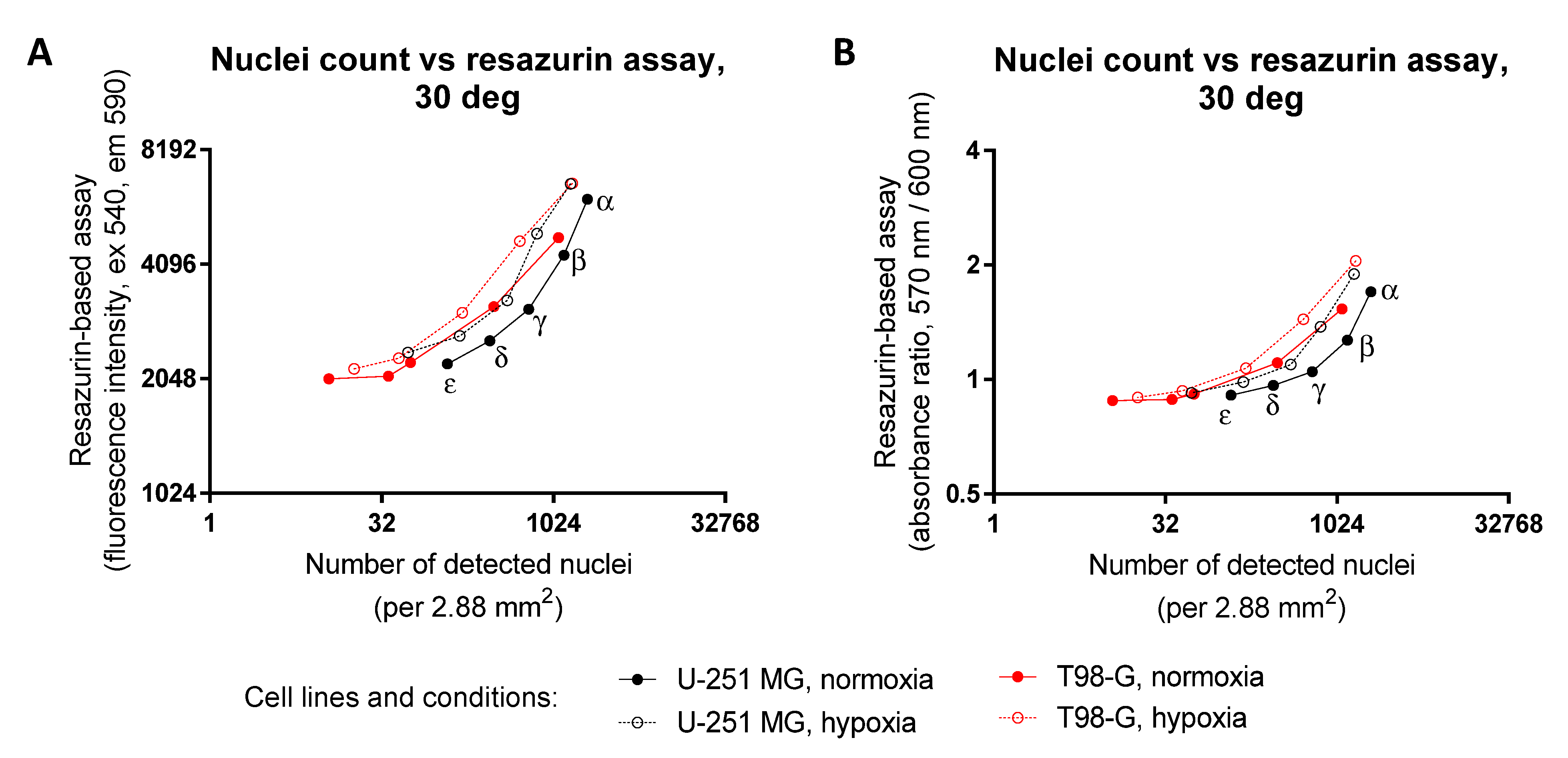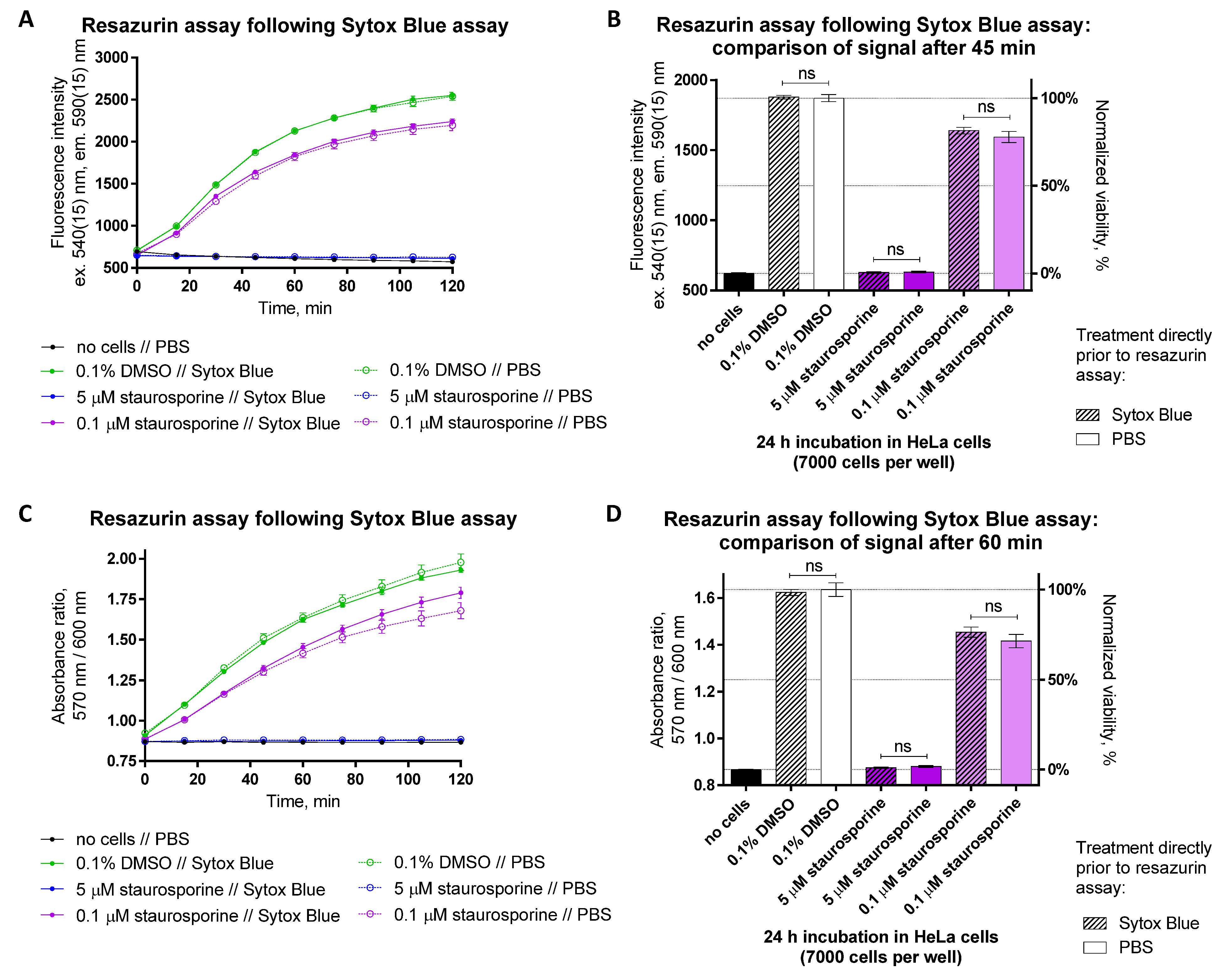Revisiting the Resazurin-Based Sensing of Cellular Viability: Widening the Application Horizon
Abstract
:1. Introduction
2. Materials and Methods
2.1. Apparatuses and Reagents
2.2. Resazurin Assay
2.2.1. Dynamic Range Experiments
2.2.2. Radiation Studies
2.2.3. Experiments with Cytotoxic and Cytostatic Agents
2.2.4. Measurement of Absorbance and Fluorescence Spectra
2.3. Microscopy Assay
2.4. Studies Using the Apoptosis Sensor Casper3-GR
2.5. Studies Using the Necrosis Sensor SYTOX Blue
2.6. Studies Using the MTT Dye
2.7. Data Analysis
3. Results and Discussion
3.1. The Dynamic Range Concept: The Choice of the Detected Optical Characteristic, Resazurin Concentration, and Assay Time
3.2. Dynamic Range Dependence on the Cell Line, Time Post-Seeding, and Time in Culture
3.3. Combination of Resazurin Assay with Irradiation Experiments
3.4. Hypoxia and Hypothermia Studies: Validation of Applicability of Resazurin Assay Using Immunofluorescence
3.5. Resazurin Assay for Characterization of Cytotoxic and Cytostatic Effects of Compounds
3.6. Applicability of Resazurin Assay for Assessment of Viability of Primary Cells
3.7. Combination of Resazurin Assay with Assays Utilizing Casper3-GR Biosensor and SYTOX Blue Dye
3.8. Comparison of the Resazurin Assay with MTT Assay
4. Conclusions
- The working principle underlying the assay is intuitively clear;
- The assay does not require highly specialized apparatuses or highly qualified workforce. In fact, a smartphone camera might be sufficient for the tasks that require semiquantitative answers [39];
- Even when used for the demandingly quantitative purposes, the assay is relatively cheap. The routine costs of the cell maintenance in culture might easily outweigh the assay costs (resazurin powder, PBS, multi-well plates, and maintenance of a multiplate reader);
- There is flexibility in the readout modes, the reaction volumes, the duration, the nature of treatment, and other parameters;
- The measurements are carried out in the bulk of the solution covering the cells, thus being minimally affected by the intracellular presence of the potentially interfering fluorescent substances (e.g., biosensors, other chemical probes, or cytotoxic agents);
- Based on observations in all cell lines and primary cells tested so far, the application of resazurin as a sensor does not require any auxiliary reagents that might interfere with chemosensitivity of cells.
- The dynamic range of the assay (regarding the number of seeded cells, the initial concentration of resazurin, the type of readout, and the assay duration) needs to be optimized for each cell line, treatment type, treatment duration, plate type, and apparatus used. For successful combination of the resazurin assay with other methods (e.g., apoptosis measurements), the set of optimized parameters should be compatible with requirements of both assays;
- Given that the resazurin assay directly measures metabolism rather than viability of cells, in cases where the treatment of cells involves substances or conditions which affect the redox balance, the results require cautious interpretation, application of a set proper treatment controls, and, whenever possible, methods based on alternative readouts (e.g., counting of cells using microscopy techniques).
Supplementary Materials
Author Contributions
Funding
Institutional Review Board Statement
Informed Consent Statement
Data Availability Statement
Acknowledgments
Conflicts of Interest
References
- Rampersad, S.N. Multiple Applications of Alamar Blue as an Indicator of Metabolic Function and Cellular Health in Cell Viability Bioassays. Sensors 2012, 12, 12347–12360. [Google Scholar] [CrossRef] [PubMed]
- Towne, V.; Will, M.; Oswald, B.; Zhao, Q. Complexities in Horseradish Peroxidase-Catalyzed Oxidation of Dihydroxyphenoxazine Derivatives: Appropriate Ranges for PH Values and Hydrogen Peroxide Concentrations in Quantitative Analysis. Anal. Biochem. 2004, 334, 290–296. [Google Scholar] [CrossRef] [PubMed]
- Bueno, C.; Villegas, M.L.; Bertolotti, S.G.; Previtali, C.M.; Neumann, M.G.; Encinas, M.V. The Excited-State Interaction of Resazurin and Resorufin with Amines in Aqueous Solutions. Photophysics and Photochemical Reactions. Photochem. Photobiol. 2002, 76, 385–390. [Google Scholar] [CrossRef]
- Magnani, E.; Bettini, E. Resazurin Detection of Energy Metabolism Changes in Serum-Starved PC12 Cells and of Neuroprotective Agent Effect. Brain Res. Protoc. 2000, 5, 266–272. [Google Scholar] [CrossRef]
- John, C.K. Place of the Methylene Blue and Resazurin Reduction Tests in a Milk Control Program. Am. J. Public Health Nations Health 1939, 29, 239–247. [Google Scholar] [CrossRef] [PubMed]
- Pfaller, M.A.; Grant, C.; Morthland, V.; Rhine-Chalberg, J. Comparative Evaluation of Alternative Methods for Broth Dilution Susceptibility Testing of Fluconazole against Candida Albicans. J. Clin. Microbiol. 1994, 32, 506–509. [Google Scholar] [CrossRef] [Green Version]
- Glass, R.H.; Ericsson, S.A.; Ericsson, R.J.; Drouin, M.T.; Marcoux, L.J.; Sullivan, H. The Resazurin Reduction Test Provides an Assessment of Sperm Activity. Fertil. Steril. 1991, 56, 743–746. [Google Scholar] [CrossRef]
- Walzl, A.; Unger, C.; Kramer, N.; Unterleuthner, D.; Scherzer, M.; Hengstschläger, M.; Schwanzer-Pfeiffer, D.; Dolznig, H. The Resazurin Reduction Assay Can Distinguish Cytotoxic from Cytostatic Compounds in Spheroid Screening Assays. J. Biomol. Screen. 2014, 19, 1047–1059. [Google Scholar] [CrossRef] [Green Version]
- Samalecos, A.; Reimann, K.; Wittmann, S.; Schulte, H.M.; Brosens, J.J.; Bamberger, A.M.; Gellersen, B. Characterization of a Novel Telomerase-Immortalized Human Endometrial Stromal Cell Line, St-T1b. Reprod. Biol. Endocrinol. RBE 2009, 7, 76. [Google Scholar] [CrossRef] [Green Version]
- Lavogina, D.; Samuel, K.; Lavrits, A.; Meltsov, A.; Sõritsa, D.; Kadastik, Ü.; Peters, M.; Rinken, A.; Salumets, A. Chemosensitivity and Chemoresistance in Endometriosis—Differences for Ectopic versus Eutopic Cells. Reprod. BioMed. Online 2019, 39, 556–568. [Google Scholar] [CrossRef]
- Lavogina, D.; Laasfeld, T.; Vardja, M.; Lust, H.; Jaal, J. Viability Fingerprint of Glioblastoma Cell Lines: Roles of Mitotic, Proliferative, and Epigenetic Targets. Sci. Rep. 2021, 11, 20338. [Google Scholar] [CrossRef] [PubMed]
- Rahnel, H.; Viht, K.; Lavogina, D.; Mazina, O.; Haljasorg, T.; Enkvist, E.; Uri, A. A Selective Biligand Inhibitor of CK2 Increases Caspase-3 Activity in Cancer Cells and Inhibits Platelet Aggregation. ChemMedChem 2017, 12, 1723–1736. [Google Scholar] [CrossRef] [PubMed]
- Lambou, M.G. 2, 3, 5-Triphenyltetrazolium Chloride as a Rapid Indicator of Viability in Cottonseed. Science 1953, 117, 690–693. [Google Scholar] [CrossRef] [PubMed]
- Schiff, D.; Chan, G.; Poznansky, M.J. Bilirubin Toxicity in Neural Cell Lines N115 and NBR10A. Pediatr Res 1985, 19, 908–911. [Google Scholar] [CrossRef] [PubMed] [Green Version]
- Riss, T.L.; Moravec, R.A.; Niles, A.L.; Duellman, S.; Benink, H.A.; Worzella, T.J.; Minor, L. Cell Viability Assays. In Assay Guidance Manual; Markossian, S., Grossman, A., Brimacombe, K., Arkin, M., Auld, D., Austin, C.P., Baell, J., Chung, T.D.Y., Coussens, N.P., Dahlin, J.L., et al., Eds.; Eli Lilly & Company and the National Center for Advancing Translational Sciences: Bethesda, MD, USA, 2004. [Google Scholar]
- Zhang, J.H.; Chung, T.D.Y.; Oldenburg, K.R. A Simple Statistical Parameter for Use in Evaluation and Validation of High Throughput Screening Assays. J. Biomol. Screen. 1999, 4, 67–73. [Google Scholar] [CrossRef] [PubMed]
- Bar, H.; Zweifach, A. Z’ Does Not Need to Be >0.5. Slas Discov. Adv. Sci. Drug Discov. 2020, 25, 1000–1008. [Google Scholar] [CrossRef] [PubMed]
- American Type Culture Collection, ATCC: Passage Number Effects in Cell Lines. Available online: https://www.atcc.org/-/media/resources/technical-documents/passage-number-effects-in-cell-lines.pdf (accessed on 14 January 2022).
- Hughes, P.; Marshall, D.; Reid, Y.; Parkes, H.; Gelber, C. The Costs of Using Unauthenticated, over-Passaged Cell Lines: How Much More Data Do We Need? BioTechniques 2007, 43, 575–586. [Google Scholar] [CrossRef]
- Paris, L.; Cordelli, E.; Eleuteri, P.; Grollino, M.G.; Pasquali, E.; Ranaldi, R.; Meschini, R.; Pacchierotti, F. Kinetics of γ-H2AX Induction and Removal in Bone Marrow and Testicular Cells of Mice after X-Ray Irradiation. Mutagenesis 2011, 26, 563–572. [Google Scholar] [CrossRef] [Green Version]
- Mariotti, L.G.; Pirovano, G.; Savage, K.I.; Ghita, M.; Ottolenghi, A.; Prise, K.M.; Schettino, G. Use of the γ-H2AX Assay to Investigate DNA Repair Dynamics Following Multiple Radiation Exposures. PLoS ONE 2013, 8, e79541. [Google Scholar] [CrossRef] [Green Version]
- Lee, Y.; Wang, Q.; Shuryak, I.; Brenner, D.J.; Turner, H.C. Development of a High-Throughput γ-H2AX Assay Based on Imaging Flow Cytometry. Radiat. Oncol. 2019, 14, 150. [Google Scholar] [CrossRef] [Green Version]
- Brix, N.; Samaga, D.; Hennel, R.; Gehr, K.; Zitzelsberger, H.; Lauber, K. The Clonogenic Assay: Robustness of Plating Efficiency-Based Analysis Is Strongly Compromised by Cellular Cooperation. Radiat. Oncol. 2020, 15, 248. [Google Scholar] [CrossRef] [PubMed]
- Strese, S.; Fryknäs, M.; Larsson, R.; Gullbo, J. Effects of Hypoxia on Human Cancer Cell Line Chemosensitivity. BMC Cancer 2013, 13, 331. [Google Scholar] [CrossRef] [PubMed] [Green Version]
- Hubbi, M.E.; Semenza, G.L. Regulation of Cell Proliferation by Hypoxia-Inducible Factors. Am. J. Physiol. Cell Physiol. 2015, 309, C775–C782. [Google Scholar] [CrossRef] [PubMed] [Green Version]
- O’Brien, J.; Wilson, I.; Orton, T.; Pognan, F. Investigation of the Alamar Blue (Resazurin) Fluorescent Dye for the Assessment of Mammalian Cell Cytotoxicity. Eur. J. Biochem. 2000, 267, 5421–5426. [Google Scholar] [CrossRef] [PubMed]
- Barnes, S.; Spenney, J.G. Stoichiometry of the Nadh-Oxidoreductase Reaction for Dehydrogenase Determinations. Clin. Chim. Acta 1980, 107, 149–154. [Google Scholar] [CrossRef]
- Ng, N.; Cabral-da-Silva, M.C.; Maksour, S.; Berg, T.; Engel, M.; Silva, D.M.; Do-Ha, D.; Lum, J.S.; Muñoz, S.S.; Suarez-Bosche, N.; et al. Identification of Repurposable Cytoprotective Drugs in Vanishing White Matter Disease Patient-Derived Cells. Transl. Med. Commun. 2020, 5, 18. [Google Scholar] [CrossRef]
- Kummar, S.; Gutierrez, M.; Doroshow, J.H.; Murgo, A.J. Drug Development in Oncology: Classical Cytotoxics and Molecularly Targeted Agents. Br. J. Clin. Pharm. 2006, 62, 15–26. [Google Scholar] [CrossRef] [Green Version]
- Rixe, O.; Fojo, T. Is Cell Death a Critical End Point for Anticancer Therapies or Is Cytostasis Sufficient? Clin. Cancer Res. 2007, 13, 7280–7287. [Google Scholar] [CrossRef] [Green Version]
- Li, X.; Marani, M.; Mannucci, R.; Kinsey, B.; Andriani, F.; Nicoletti, I.; Denner, L.; Marcelli, M. Overexpression of BCL-XL Underlies the Molecular Basis for Resistance to Staurosporine-Induced Apoptosis in PC-3 Cells1. Cancer Res. 2001, 61, 1699–1706. [Google Scholar]
- Gong, X.; Liang, Z.; Yang, Y.; Liu, H.; Ji, J.; Fan, Y. A Resazurin-Based, Nondestructive Assay for Monitoring Cell Proliferation during a Scaffold-Based 3D Culture Process. Regen. Biomater. 2020, 7, 271–281. [Google Scholar] [CrossRef]
- Erikstein, B.S.; Hagland, H.R.; Nikolaisen, J.; Kulawiec, M.; Singh, K.K.; Gjertsen, B.T.; Tronstad, K.J. Cellular Stress Induced by Resazurin Leads to Autophagy and Cell Death via Production of Reactive Oxygen Species and Mitochondrial Impairment. J. Cell Biochem. 2010, 111, 574–584. [Google Scholar] [CrossRef] [PubMed] [Green Version]
- Pace, R.T.; Burg, K.J.L. Toxic Effects of Resazurin on Cell Cultures. Cytotechnology 2015, 67, 13–17. [Google Scholar] [CrossRef] [Green Version]
- Shcherbo, D.; Souslova, E.A.; Goedhart, J.; Chepurnykh, T.V.; Gaintzeva, A.; Shemiakina, I.I.; Gadella, T.W.; Lukyanov, S.; Chudakov, D.M. Practical and Reliable FRET/FLIM Pair of Fluorescent Proteins. BMC Biotechnol. 2009, 9, 24. [Google Scholar] [CrossRef] [PubMed] [Green Version]
- Chiaraviglio, L.; Kirby, J.E. Evaluation of Impermeant, DNA-Binding Dye Fluorescence as a Real-Time Readout of Eukaryotic Cell Toxicity in a High Throughput Screening Format. Assay Drug Dev. Technol. 2014, 12, 219–228. [Google Scholar] [CrossRef] [PubMed] [Green Version]
- Molecular Probes: SYTOX Blue Dead Cell Stain. Available online: https://www.thermofisher.com/document-connect/document-connect.html?url=https%3A%2F%2Fassets.thermofisher.com%2FTFS-Assets%2FLSG%2Fmanuals%2Fmp34857.pdf (accessed on 17 January 2022).
- Roche: Colorimetric Assay (MTT Based) for the Nonradioactive Quantification of Cell Proliferation and Viability. Available online: https://www.sigmaaldrich.com/deepweb/assets/sigmaaldrich/product/documents/117/135/11465007001bul.pdf (accessed on 25 February 2022).
- Needs, S.H.; Osborn, H.M.I.; Edwards, A.D. Counting Bacteria in Microfluidic Devices: Smartphone Compatible ‘Dip-and-Test’ Viable Cell Quantitation Using Resazurin Amplified Detection in Microliter Capillary Arrays. J. Microbiol. Methods 2021, 187, 106199. [Google Scholar] [CrossRef]











| Transfection Status 1 | Number of Seeded Cells Per Well | log (IC50/M): Resazurin Assay | log (IC50/M): Apoptosis Assay 2 | ||
|---|---|---|---|---|---|
| Staurosporine | Bortezomib | Staurosporine | Bortezomib | ||
| NT | 2 × 104 | −7.7 ± 0.2 | −7.3 ± 0.2 | NM | NM |
| Casper3-GR | 4 × 104 | −7.6 ± 0.2 | −7.4 ± 0.2 | −8.13 ± 0.08 | −7.9 ± 0.2 |
| Casper3-GR | 4 × 104 | −6.8 ± 0.6 | −7.32 ± 0.03 | −8.7 ± 0.2 | −7.6 ± 0.2 |
Publisher’s Note: MDPI stays neutral with regard to jurisdictional claims in published maps and institutional affiliations. |
© 2022 by the authors. Licensee MDPI, Basel, Switzerland. This article is an open access article distributed under the terms and conditions of the Creative Commons Attribution (CC BY) license (https://creativecommons.org/licenses/by/4.0/).
Share and Cite
Lavogina, D.; Lust, H.; Tahk, M.-J.; Laasfeld, T.; Vellama, H.; Nasirova, N.; Vardja, M.; Eskla, K.-L.; Salumets, A.; Rinken, A.; et al. Revisiting the Resazurin-Based Sensing of Cellular Viability: Widening the Application Horizon. Biosensors 2022, 12, 196. https://doi.org/10.3390/bios12040196
Lavogina D, Lust H, Tahk M-J, Laasfeld T, Vellama H, Nasirova N, Vardja M, Eskla K-L, Salumets A, Rinken A, et al. Revisiting the Resazurin-Based Sensing of Cellular Viability: Widening the Application Horizon. Biosensors. 2022; 12(4):196. https://doi.org/10.3390/bios12040196
Chicago/Turabian StyleLavogina, Darja, Helen Lust, Maris-Johanna Tahk, Tõnis Laasfeld, Hans Vellama, Naila Nasirova, Markus Vardja, Kattri-Liis Eskla, Andres Salumets, Ago Rinken, and et al. 2022. "Revisiting the Resazurin-Based Sensing of Cellular Viability: Widening the Application Horizon" Biosensors 12, no. 4: 196. https://doi.org/10.3390/bios12040196





